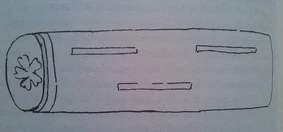
Shoninki illustration
Donohi were body warming devices used by the shinobi to survive harsh cold weather. The body warmers were made of bamboo, iron or copper. They contained flammable materials such as gunpowder, alcohol, charcoal powder, and charred cloth or mushrooms. A fire-starting tool called a tsuketake was usually attached to the donohi to set the fuel ablaze. Once lit, the fuel could burn for hours, even days.
According to the Shoninki shinobi manual, it was a "most favorable asset". Natori's donohi is made out of a copper cylinder 6.5 inches in length and 5.5 inches in circumference with caps on both ends. There would be threadlike holes sawed through the copper cylinder to let air in and warmth escape. Hemp or cotton would be twisted around a thin iron rod after being rinsed in water and kneaded. The cloth would be charred black and wrapped in paper. This would be used as the fuel inside the donohi. To help it burn Sugiharagami paper would be used as a wick. This type of paper was made out of mulberry trees. Natori urges the reader to experiment with different materials such as old paper, bistort, persimmon seeds and rotting wood. These would also be charred. Bistort would be fine if the shinobi only used the donohi for warmth. Natori claims that the donohi would keep smoldering for 13 hours.

Hosho paper
The Giyoshu military manual describes several donohi variations. One is constructed by exposing young bamboo sheaves to rain for a hundred days, afterwards the sheaves are charred. Early ripening rice straw would be crumbled up into a bundle with one side fastened. The other side would be cut off, charred, formed into a sphere the size of a yuzu fruit, ignited, placed into the straw bundle and the bundle would be wrapped in a tenugui cloth.
Another version is made up of crumpled up hosho, a thick paper, torn into pieces and formed into a sphere. It would be ignited and completely wrapped in several layers of crumpled up paper. A final version is constructed out of dry rice samplings weaved into a hallow sphere with a tinder made from sugihara paper.